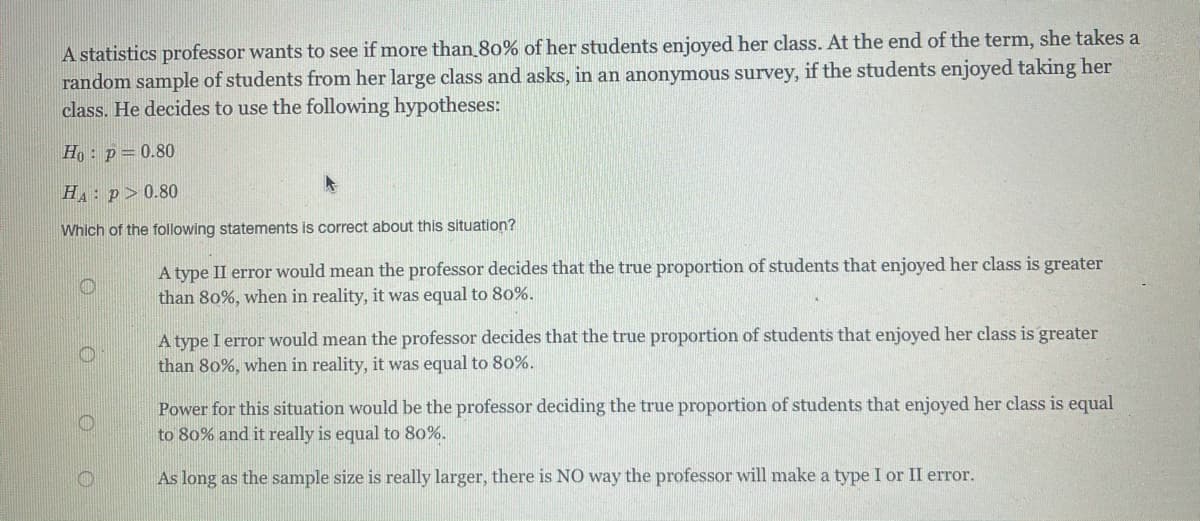A statistics professor wants to see if more than 80% of her students enjoyed her class. At the end of the term, she takes a random sample of students from her large class and asks, in an anonymous survey, if the students enjoyed taking her class. He decides to use the following hypotheses: Ho: p=0.80 HA: p> 0.80 Which of the following statements is correct about this situation? A type II error would mean the professor decides that the true proportion of students that enjoyed her class is greater than 80%, when in reality, it was equal to 80%. A type I error would mean the professor decides that the true proportion of students that enjoyed her class is greater than 80%, when in reality, it was equal to 80%. Power for this situation would be the professor deciding the true proportion of students that enjoyed her class is equal to 80% and it really is equal to 80%. As long as the sample size is really larger, there is NO way the professor will make a type I or II error.
A statistics professor wants to see if more than 80% of her students enjoyed her class. At the end of the term, she takes a random sample of students from her large class and asks, in an anonymous survey, if the students enjoyed taking her class. He decides to use the following hypotheses: Ho: p=0.80 HA: p> 0.80 Which of the following statements is correct about this situation? A type II error would mean the professor decides that the true proportion of students that enjoyed her class is greater than 80%, when in reality, it was equal to 80%. A type I error would mean the professor decides that the true proportion of students that enjoyed her class is greater than 80%, when in reality, it was equal to 80%. Power for this situation would be the professor deciding the true proportion of students that enjoyed her class is equal to 80% and it really is equal to 80%. As long as the sample size is really larger, there is NO way the professor will make a type I or II error.
MATLAB: An Introduction with Applications
6th Edition
ISBN:9781119256830
Author:Amos Gilat
Publisher:Amos Gilat
Chapter1: Starting With Matlab
Section: Chapter Questions
Problem 1P
Related questions
Topic Video
Question

Transcribed Image Text:A statistics professor wants to see if more than 80% of her students enjoyed her class. At the end of the term, she takes a
random sample of students from her large class and asks, in an anonymous survey, if the students enjoyed taking her
class. He decides to use the following hypotheses:
Ho : p=0.80
H: p>0.80
Which of the following statements is correct about this situation?
A type II error would mean the professor decides that the true proportion of students that enjoyed her class is greater
than 80%, when in reality, it was equal to 80%.
A type I error would mean the professor decides that the true proportion of students that enjoyed her class is greater
than 80%, when in reality, it was equal to 80%.
Power for this situation would be the professor deciding the true proportion of students that enjoyed her class is equal
to 80% and it really is equal to 80%.
As long as the sample size is really larger, there is NO way the professor will make a type I or II error.
Expert Solution
This question has been solved!
Explore an expertly crafted, step-by-step solution for a thorough understanding of key concepts.
This is a popular solution!
Trending now
This is a popular solution!
Step by step
Solved in 2 steps

Knowledge Booster
Learn more about
Need a deep-dive on the concept behind this application? Look no further. Learn more about this topic, statistics and related others by exploring similar questions and additional content below.Recommended textbooks for you

MATLAB: An Introduction with Applications
Statistics
ISBN:
9781119256830
Author:
Amos Gilat
Publisher:
John Wiley & Sons Inc

Probability and Statistics for Engineering and th…
Statistics
ISBN:
9781305251809
Author:
Jay L. Devore
Publisher:
Cengage Learning

Statistics for The Behavioral Sciences (MindTap C…
Statistics
ISBN:
9781305504912
Author:
Frederick J Gravetter, Larry B. Wallnau
Publisher:
Cengage Learning

MATLAB: An Introduction with Applications
Statistics
ISBN:
9781119256830
Author:
Amos Gilat
Publisher:
John Wiley & Sons Inc

Probability and Statistics for Engineering and th…
Statistics
ISBN:
9781305251809
Author:
Jay L. Devore
Publisher:
Cengage Learning

Statistics for The Behavioral Sciences (MindTap C…
Statistics
ISBN:
9781305504912
Author:
Frederick J Gravetter, Larry B. Wallnau
Publisher:
Cengage Learning

Elementary Statistics: Picturing the World (7th E…
Statistics
ISBN:
9780134683416
Author:
Ron Larson, Betsy Farber
Publisher:
PEARSON

The Basic Practice of Statistics
Statistics
ISBN:
9781319042578
Author:
David S. Moore, William I. Notz, Michael A. Fligner
Publisher:
W. H. Freeman

Introduction to the Practice of Statistics
Statistics
ISBN:
9781319013387
Author:
David S. Moore, George P. McCabe, Bruce A. Craig
Publisher:
W. H. Freeman